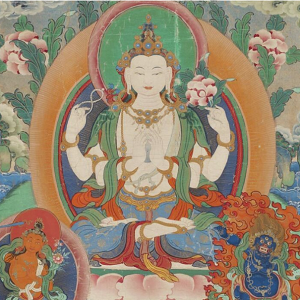National Museum of Asian Art
The National Museum of Asian Art is part of the Smithsonian museum network. It includes the Freer Gallery of Art and the Arthur M. Sackler Gallery and is located on the National Mall in Washington, D.C. The museum opened in 1923 and has grown to feature 45,000 artworks. Over the years, they have partnered with several Asian nations and their art institutions to loan art. Starting in February 2023, the museum entered an agreement with the Yemeni government to hold 77 artworks that had been looted from the country until the end of the country’s civil war, at which point they will be returned.
The museum offers a wide variety of teaching resources. Some of these focus on individual countries, including China and Edo Japan; teaching posters on Quranic art, Chinese hand scrolls, Japanese painting, the museum’s Peacock Room, and Ancient Egypt; and lesson plans on various artistic styles and mediums. The museum also offers lesson plans on how to look at objects which are intended to introduce younger students to material culture and art analysis.
The Chinese teaching resources include searchable databases of objects which provide background information, analysis, and engagement questions for each object. The resources also include short essays on each period of Chinese history and themes across those periods which are intended to give background information on that period/theme to educators. Additionally, there is a database of searchable lesson plans within Chinese history on topics such as art, society, symbols, material culture, music, philosophy and religion, and culture. Each lesson plan includes a list of the subjects covered, applicable grade levels, themes, time period, necessary time, objective, guiding questions, worksheets, background, vocabulary, procedure, possible extensions, and further resources. As such, the lesson plans are very thorough and are intended to be useable for both educators who are familiar with Chinese history and those who are new to the subject. The resources also include a bank of videos on Chinese art and culture, and a variety of interactives. These interactives include annotated images, 360° images, 3D models, interactive maps, story maps, and a timeline of Chinese history with pictures.
The Japanese teaching resources include introductory materials, suggested readings, thematic lesson plans on various painting topics and techniques, videos on individual artworks, and a longer purchasable film about Edo Avant Garde art. Whereas the Chinese resources are more targeted at teaching Chinese history alongside Chinese art, the Japanese resources are much more targeted at teaching art only.
The teaching posters are dedicated to teaching students how to “read” different types of artworks and provide background information on various art mediums, time periods, as well as individual artworks. They include guiding questions for evaluating art and additional resources such as related artworks and standards alignment statements.
Finally, the museum also hosts lesson plans which are not dedicated to Chinese history. These are mostly focused on various art forms, individual artists and artworks. Like the Chinese lesson plans, these include applicable subjects, grade levels, necessary time, goals, guiding questions, vocabulary, standards alignment statements, background information, context, procedure, additional resources, and worksheets.
Because the museum is dedicated to Asian art, its educational resources are largely meant to teach students about art. However, for educators who wish to include art and material culture in their history classrooms or who are teaching art history, these could be useful resources. Additionally, because art and material culture have been so central to cultural expression throughout history, these resources, all of which include background information which could introduce educators to new subjects, could be a good way to integrate cultural history into the classroom. The museum is limited in that it has a heavy bias toward East Asia, in particular China and Japan. However, they also include some Islamic art which could be useful in teaching about southwest Asia. Additionally, the museum is somewhat limited in its time span, focusing mostly before the 20th century.
